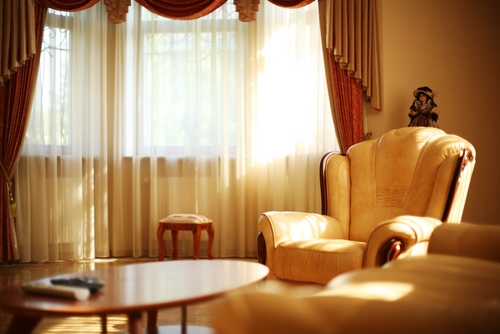
When it comes to window treatments, you have your choice between four main styles – shades, shutters, blinds and drapes. Each one has its own set of characteristics to best suit your needs. As you decide which designs to buy for your home, you'll want to consider each and every room in terms of its light, heat and aesthetic requirements. Here to help you decide is an introduction to window coverings and how to pick the right ones.
Windows are an essential element to your home – not just for privacy or blocking light at night, but also for regulating the temperature of your home. Sunlight through your windows can provide solar gain, thereby warming your home. However, blinds are key in regulating the amount of solar gain, especially in the summer months, when rooms are liable to overheat. In the wintertime, you also run the risk of losing heat through glass, which is a poor insulator. Window treatments help to retain heat in winter months and during cold nights.
A treatment for every situation
Some of these window treatments are better at insulating and blocking light than others. However, you don't just want to pick the best insulator for every room, as you'll likely have different light, heat and privacy needs from room to room. The southern-facing wall of your home, for example, will let in the most light of any facade, and as such you may want heavy shades to block out the sun on really hot days. Because many people choose house floor plans with large bay windows on the south side to let in light, you'll also have more heat radiating through the glass in the winter. Closed window treatments during cold nights are also essential to retaining heat. North-facing walls, however, receive little light and so don't require as much shade. Lightweight drapes that allow light may be a better option.
Also, consider the various privacy requirements for two-story house plans, such as this one, compared to single-story craftsman house plans. Downstairs, thin drapes may be fine, but for upstairs bedrooms, you'll still want something opaque so that light doesn't get in and privacy is afforded. With the south-facing great room, however, slatted blinds may be preferable.
Shutters
This type of window treatment is often used purely as decoration on the side of neocolonial homes, though many are not actually able to shut. However, they do provide a sturdy treatment that can reduce temperature fluctuations in a home. According to the U.S. Department of Energy, a solid shutter fitted close to a window frame creates an insulating air space. They can also be combined with other shading elements for greater insulation. They also provide a physical barrier from the elements.
Drapes
The insulating abilities of drapes depends largely on the fabric being used. If you want a lot of insulation, then thick, dark drapes that layer atop one another are your best option. However, you can also use thin drapes to create soft lighting a room.
Shades and blinds
The terms shades and blinds are often used interchangeably, but in general, blinds have slats. Because these slats are often adjustable, they allow homeowners flexibility in terms of letting in light and air. However, slats also create small slits where air can get through, making them less effective at retaining heat in the winter.
Unlike blinds, shades are generally comprised of a single piece of fabric that can be pulled down over glass. These are highly effective means of insulation that can be improved upon through layers and sealed edges.